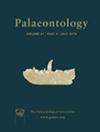中晚三叠世环境障碍对腾蛇生物地理学和扩散的影响
IF 2.3
2区 地球科学
Q1 PALEONTOLOGY
引用次数: 0
摘要
在周期性干旱气候时期的三叠纪,栉水母类曾在全球范围内广泛分布,是三叠纪陆地生态系统的稳定组成部分。考虑到三叠纪软体动物与现代软体动物之间的祖先关系,我们有必要认识到,三叠纪软体动物可能具有一定程度的生态复原力和适应性。尽管具有较高的可塑性,但铁姆诺皮龙可能仍然容易受到环境和气候变化的影响。虽然化石地点分布零散,但我们试图通过将实际化石地点与从大气环流模型中得出的环境条件相结合,来规避目前的地理和地质偏差。在这里,我们利用物种分布模型来研究欧洲栉水母在中三叠世向晚三叠世过渡期间的古地理和古气候分布。该模型显示了不同的天牛栖息地适宜区域,为了解天牛的生物地理分布模式和扩散潜力提供了新的视角。我们认为,中欧盆地是三叠纪栉水母类多样化和扩散的焦点。此外,本文还首次将物种分布模型应用于三叠纪天牛的研究,有助于了解其气候生态位的占据和演化。本文章由计算机程序翻译,如有差异,请以英文原文为准。
Impact of environmental barriers on temnospondyl biogeography and dispersal during the Middle–Late Triassic
Temnospondyls had a remarkable worldwide distribution throughout the Triassic at a time of periodic arid climates, and were a stable component of Triassic terrestrial ecosystems. Given the postulated ancestral relationship between temnospondyls and modern lissamphibians it is pertinent to recognize that the group may have exhibited some degree of ecological resilience and adaptability. Despite this higher level of plasticity, temnospondyls might still have been susceptible to environmental and climate changes. Although fossil sites are distributed sporadically, we try to circumvent the present geographical and geological biases by combining actual fossil occurrences with environmental conditions derived from general circulation models. Here, we employ species distribution modelling to examine the palaeogeographic and palaeoclimatic distribution of European temnospondyls during the transition from Middle to Late Triassic. The model shows different suitable areas for temnospondyl habitats that give new potential insights on the biogeographic distribution patterns and dispersal potential. We suggest that the Central European Basin functioned as a focal point for Triassic temnospondyl diversification and spread. Moreover, this paper provides the first application of species distribution modelling for Triassic temnospondyls and aids in understanding their climatic niche occupation and evolution.
求助全文
通过发布文献求助,成功后即可免费获取论文全文。
去求助
来源期刊

Palaeontology
地学-古生物学
CiteScore
5.60
自引率
3.80%
发文量
43
审稿时长
6 months
期刊介绍:
Palaeontology publishes a wide variety of papers on palaeontological topics covering:
palaeozoology
palaeobotany
systematic studies
palaeoecology
micropalaeontology
palaeobiogeography
functional morphology
stratigraphy
taxonomy
taphonomy
palaeoenvironmental reconstruction
palaeoclimate analysis and biomineralization studies.
 求助内容:
求助内容: 应助结果提醒方式:
应助结果提醒方式:


